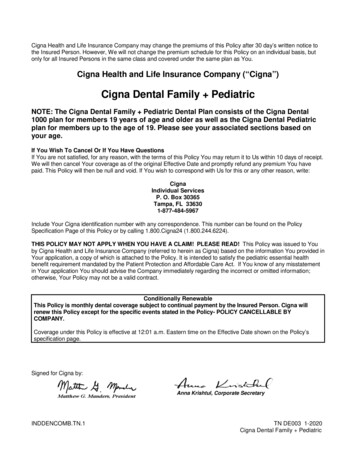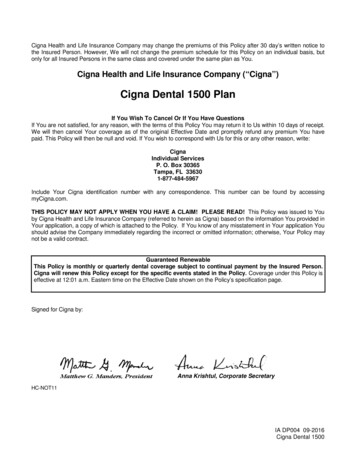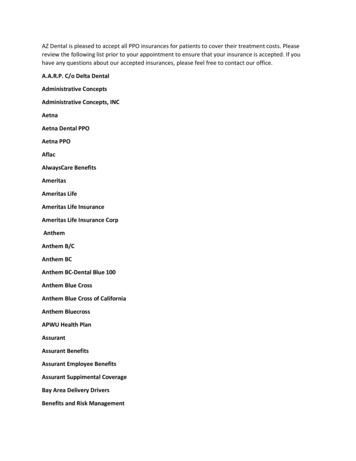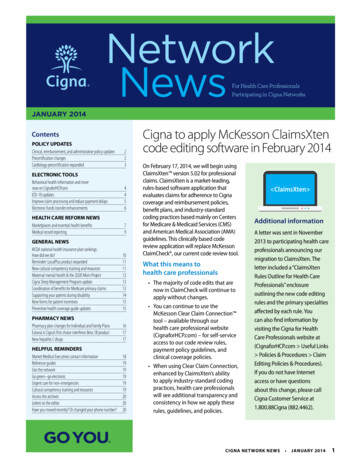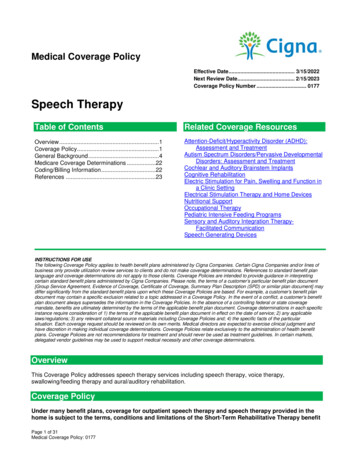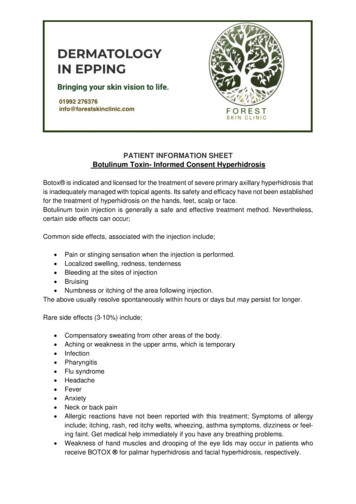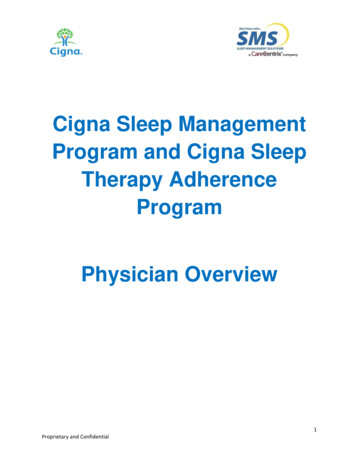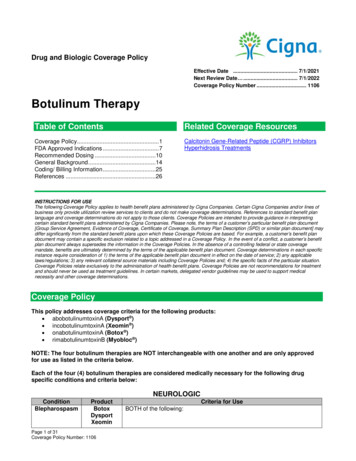
Transcription
Drug and Biologic Coverage PolicyEffective Date . 7/1/2021Next Review Date . 7/1/2022Coverage Policy Number . 1106Botulinum TherapyTable of ContentsRelated Coverage ResourcesCoverage Policy.1FDA Approved Indications .7Recommended Dosing .10General Background .14Coding/ Billing Information .25References .26Calcitonin Gene-Related Peptide (CGRP) InhibitorsHyperhidrosis TreatmentsINSTRUCTIONS FOR USEThe following Coverage Policy applies to health benefit plans administered by Cigna Companies. Certain Cigna Companies and/or lines ofbusiness only provide utilization review services to clients and do not make coverage determinations. References to standard benefit planlanguage and coverage determinations do not apply to those clients. Coverage Policies are intended to provide guidance in interpretingcertain standard benefit plans administered by Cigna Companies. Please note, the terms of a customer’s particular benefit plan document[Group Service Agreement, Evidence of Coverage, Certificate of Coverage, Summary Plan Description (SPD) or similar plan document] maydiffer significantly from the standard benefit plans upon which these Coverage Policies are based. For example, a customer’s benefit plandocument may contain a specific exclusion related to a topic addressed in a Coverage Policy. In the event of a conflict, a customer’s benefitplan document always supersedes the information in the Coverage Policies. In the absence of a controlling federal or state coveragemandate, benefits are ultimately determined by the terms of the applicable benefit plan document. Coverage determinations in each specificinstance require consideration of 1) the terms of the applicable benefit plan document in effect on the date of service; 2) any applicablelaws/regulations; 3) any relevant collateral source materials including Coverage Policies and; 4) the specific facts of the particular situation.Coverage Policies relate exclusively to the administration of health benefit plans. Coverage Policies are not recommendations for treatmentand should never be used as treatment guidelines. In certain markets, delegated vendor guidelines may be used to support medicalnecessity and other coverage determinations.Coverage PolicyThis policy addresses coverage criteria for the following products: abobotulinumtoxinA (Dysport ) incobotulinumtoxinA (Xeomin ) onabotulinumtoxinA (Botox ) rimabotulinumtoxinB (Myobloc )NOTE: The four botulinum therapies are NOT interchangeable with one another and are only approvedfor use as listed in the criteria below.Each of the four (4) botulinum therapies are considered medically necessary for the following drugspecific conditions and criteria DysportXeominPage 1 of 31Coverage Policy Number: 1106Criteria for UseBOTH of the following:
ConditionProductCriteria for UseTreatment for blepharospasm characterized by intermittent orsustained closure of the eyelids caused by involuntary contractions ofthe orbicularis oculi muscle Prescribed by, or in consultation with, a neurologist or ophthalmologistTreatment when ALL of the following are present: Involuntary, simultaneous activation of agonist and antagonist musclesof the neck and shoulder (for example, sternocleidomastoid, splenius,levator scapulae, trapezius, semispinalis, scalene) Sustained head torsion and/or tilt with limited range of motion in theneck Prescribed by, or in consultation with, a board certified painmanagement specialist, a neurologist or a physical medicine andrehabilitation physicianInitial Authorization CriteriaALL of the following are met: Diagnosis of chronic migraine headache as defined by 15 days ormore per month with headache lasting four hours a day or longer in anadult Documented failure or inadequate response following a minimum 3month trial, contraindication per FDA label, intolerance, or not acandidate for at least TWO different prescription migraine preventiontherapies from different classes of migraine prophylaxis medications:o Antiepileptic drugs (divalproex, sodium valproate, topiramate)o Antidepressants (amitriptyline, venlafaxine)o Beta blockers (metoprolol, propranolol, timolol, atenolol, nadolol) Prescribed by, or in consultation with, a board certified painmanagement specialist or a neurologist vention BotoxReauthorization CriteriaOngoing therapy may be approved after 1 year for individuals meeting bothof the following: Continue to meet the initial authorization criteria Either of the following:o Reduction in monthly migraine days or hourso Reduction in days requiring acute migraine-specific treatmentThe concurrent use of onabotulinumtoxinA (Botox) witheptinezumab-jjmr (Vyepti), erenumab-aooe (Aimovig), fremanezumabvfrm (Ajovy) or galcanezumab-gnlm (Emgality) is consideredmedically necessary when ALL of the following criteria are met: Individual is 18 years of age or older For the preventative treatment of chronic migraine in an individualcontinuing to experience 4 or more migraine headache days per monthafter therapy with ONE of the following:o A minimum 3 month trial of eptinezumab-jjmr (Vyepti), erenumabaooe (Aimovig), fremanezumab-vfrm (Ajovy) or galcanezumabgnlm (Emgality)o A minimum 6 month trial (2 injection cycles) of onabotulinumtoxinA(Botox) All prerequisite therapy requirements, above, have been metEssentialtremorBotoxPage 2 of 31Coverage Policy Number: 1106BOTH of the following: Treatment of disabling condition (including head, neck, hand, andvoice tremor)
ConditionProductCriteria for UsePrescribed by, or in consultation with, a board certified painmanagement specialist, a neurologist or a physical medicine andrehabilitation physicianBOTH of the following: Treatment for any the following:o Focal hand dystonia (for example, writer's cramp) causingpersistent pain or interfering with the ability to perform age-relatedactivities of daily livingo Adductor spasmodic dysphonia/laryngeal dystoniao Jaw-closing oromandibular dystoniao Meige's syndrome/cranial dystonia (i.e., blepharospasm) Prescribed by, or in consultation with, a board certified painmanagement specialist, a neurologist, otolarnygologist or a physicalmedicine and rehabilitation physicianBOTH of the following: Treatment for any the following:o Hemifacial spasmso Seventh cranial nerve palsy (Bell’s Palsy)o Gaze palsies causing persistent pain or vision impairment Prescribed by, or in consultation with, a board certified painmanagement specialist, a neurologist or a physical medicine andrehabilitation physicianBOTH of the following: Treatment for any the following:o Cerebral palsy (including spastic equinus foot deformities)o Localized adductor muscle spasticity in multiple sclerosiso Spinal cord injuryo Traumatic brain injuryo Hereditary spastic paraplegiao Lower limb spasticity with documentation of significant decrease offunction or Activities of Daily Living (for example, walking) inpediatric or adult individualso Upper limb spasticity with documented significant decrease offunction or Activities of Daily Living (for example, washing, eating)in pediatric or adult individuals Prescribed by, or in consultation with, a board certified painmanagement specialist, a neurologist or a physical medicine andrehabilitation physicianBOTH of the following: Treatment for any the following:o Cerebral palsy (including spastic equinus foot deformities)o Spasticity in multiple sclerosiso Lower limb spasticity with documentation of significant decrease offunction or Activities of Daily Living (for example, walking) inpediatric or adult individualso Upper limb spasticity with documented significant decrease offunction or Activities of Daily Living (for example, washing, eating)in pediatric or adult individuals Prescribed by, or in consultation with, a board certified painmanagement specialist, a neurologist or a physical medicine andrehabilitation physicianBOTH of the following: Treatment for any the following: toxDysportMyoblocPage 3 of 31Coverage Policy Number: 1106
ConditionProductCriteria for UseLower limb spasticity with documentation of significant decrease offunction or Activities of Daily Living (for example, walking) in adultso Upper limb spasticity with documented significant decrease offunction or Activities of Daily Living (for example, washing, eating)in adults Prescribed by, or in consultation with, a board certified painmanagement specialist, a neurologist or a physical medicine andrehabilitation physicianBOTH of the following: Treatment for any the following:o Lower limb spasticity with documentation of significant decrease offunction or Activities of Daily Living (for example, walking) inpediatric or adult individualso Upper limb spasticity with documented significant decrease offunction or Activities of Daily Living (for example, washing, eating)in pediatric or adult individuals Prescribed by, or in consultation with, a board certified painmanagement specialist, a neurologist or a physical medicine andrehabilitation physicianoXeominGASTROINTESTINALConditionChronic larsecretionProductBotoxSialorrhearesulting fromCerebralPalsyBotoxMyoblocCriteria for UseBOTH of the following: Treatment following failure of conventional non-surgical treatment (forexample, nitrate preparations, sitz baths, stool softeners, bulk agents,diet modifications) Prescribed by, or in consultation with, a gastroenterologist or a surgeonBOTH of the following: Treatment of obstructive symptoms due to a non-relaxing internal analsphincter following surgery for Hirschsprung disease Prescribed by, or in consultation with, a gastroenterologist or a surgeonBOTH of the following: Treatment with any of the following:o Concomitant illness and/or high risk for complications from myotomyor dilationo Poor response to prior myotomy or dilationo History of perforation caused by previous pneumatic dilationo Epiphrenic diverticulum Prescribed by, or in consultation with, a gastroenterologistEXOCRINEPage 4 of 31Coverage Policy Number: 1106Criteria for UseBOTH of the following: Treatment of cholinergic-mediated secretions associated with a fistula (forexample, parotid gland, pharyngocutaneous) refractory topharmacotherapy (including anticholinergics) Prescribed by, or in consultation with, a dermatologist, an endocrinologist,a neurologist or an otolaryngologistBOTH of the following: Documented failure / inadequate response, contraindication per FDAlabel, intolerance, or not a candidate for ONE of the following:o Atropineo Glycopyrolate
ConditionProductCriteria for UsePrescribed by, or in consultation with, an endocrinologist, a neurologist oran otolaryngologistBOTH of the following: Documented failure / inadequate response, contraindication per FDAlabel, intolerance, or not a candidate for ONE of the following:o Glycopyrolateo Scopolamine Prescribed by, or in consultation with, an endocrinologist, a neurologist oran otolaryngologistALL of the following: Treatment of chronic sialorrhea (excessive salivation present for 3 monthsor longer) in an adult, resulting from ONE of the following:o Parkinson’s diseaseo Strokeo Traumatic brain injury Documented failure / inadequate response, contraindication per FDAlabel, intolerance, or not a candidate for ONE of the following:o Glycopyrolateo Scopolamine Prescribed by, or in consultation with, an endocrinologist, a neurologist oran otolaryngologistTreatment for ANY of the following when the associated criteria are met: Primary axillary hyperhidrosis inadequately managed with a prescriptiontopical agent and BOTH of the following:o ONE of the following: The condition is significantly interfering with the ability to performage-appropriate activities of daily living The condition is causing persistent or chronic cutaneousconditions such as skin maceration, dermatitis, fungal infectionsand secondary microbial conditionso Prescribed by, or in consultation with, a dermatologist, anendocrinologist or a neurologist Sialorrhearesulting nMyoblocHyperhidrosisBotox Palmar hyperhidrosis refractory to conventional medical treatmentincluding both topical and systemic pharmacotherapy (unless clinicallycontraindicated) and BOTH of the following:o ONE of the following: The condition is significantly interfering with the ability to performage-appropriate activities of daily living The condition is causing persistent or chronic cutaneousconditions such as skin maceration, dermatitis, fungal infectionsand secondary microbial conditionso Prescribed by, or in consultation with, a dermatologist, anendocrinologist or a neurologist Gustatory sweating (Frey's syndrome, diabetic gustatory sweating) andthe following:o Prescribed by, or in consultation with, a dermatologist, anendocrinologist or a neurologistOPHTHALMOLOGICPage 5 of 31Coverage Policy Number: 1106
ConditionStrabismusdisordersin adultsProductBotoxStrabismusdisordersin childrenBotoxCriteria for UseALL of the following: Treatment when any of the following is present:o Horizontal strabismus up to 50 prism diopterso Vertical strabismuso Persistent sixth nerve palsy of one month or longer duration WITHANY of the following: Diplopia Impaired depth perception Impaired peripheral vision Impaired ability to maintain fusion Prescribed by, or in consultation with, a neurologist or ophthalmologistBOTH of the following: Treatment to achieve normal binocular motor alignment Prescribed by, or in consultation with, a neurologist or ProductBotoxCriteria for UseBOTH of the following: Treatment of ONE of the following:o Overactive bladder (OAB) with symptoms of urge urinaryincontinence, urgency, and frequency, in adults who have aninadequate response to or are intolerant of a trial of two agents fromeither of the following classes: anticholinergic medications (forexample, darifenacin, fesoterodine, flavoxate, oxybutynin, solifenacin,tolterodine, trospium) OR beta-3 adrenergic agonists* (for example,Myrbetriq, Gemtesa)o Urinary incontinence due to detrusor overactivity in adults who havean inadequate response to or are intolerant of an anticholinergicmedication (for example, darifenacin, fesoterodine, flavoxate,oxybutynin, solifenacin, tolterodine, trospium) OR a beta-3adrenergic agonist* (for example, Myrbetriq, Gemtesa) whenassociated with any of the following: Multiple sclerosis (MS) Spina bifida Spinal cord injury (SCI) Intracranial lesion or cerebrovascular accident (CVA)Interstitial cystitis/bladder pain syndrome when there is an inadequateresponse to other second- and third-line treatment options (forexample, oral or intravesical treatments and cystoscopy)Prescribed by, or in consultation with, a urologist or gynecologisto *May require prior authorizationThe botulinum therapy products are considered not medically necessary for all other indicationsincluding the following: Cosmetic purposesInitial authorization is up to four (4) treatments in a 12 month period (one [1] treatment every 90 days).If the initial approval criteria (listed above) are met AND clinical improvement with previous BotulinumTherapy is documented but duration of benefit is less than 90 days/treatment, then up to six treatmentsin a 12 month period (one treatment per 60 days) may be considered on a case-by-case basis.Page 6 of 31Coverage Policy Number: 1106
Botulinum Therapy is considered medically necessary for continued use when the following are met: Initial criteria are met Documentation of a positive clinical responseReauthorization for up to 12 months.When coverage is available and medically necessary, the dosage, frequency, duration of therapy, andsite of care should be reasonable, clinically appropriate, and supported by evidence-based literature andadjusted based upon severity, alternative available treatments, and previous response to therapy.Botulinum Therapy is considered experimental, investigational or unproven for ANY other use includingthe following: Bruxism Chronic low back pain Gastroparesis Headache including:o Cervicogenic headacheo Chronic daily headacheo Episodic migraine headache (i.e., 14 headache days or fewer per month)o Menstrual headache (for example, 90% of attacks generally occur between two days before mensesand the last day of menses)o Tension-type headache Hemorrhoid pain Lateral epicondylitis Nausea and vomiting, post sleeve gastrectomy Myofascial pain Plantar Hyperhidrosis Spastic pelvic floor syndrome Sphincter of Oddi dysfunction Temporomandibular joint (TMJ) syndrome Tics Trigeminal Neuralgia Voiding dysfunction associated with benign prostatic hyperplasiaNote: Receipt of sample product does not satisfy any criteria requirements for coverage.FDA Approved IndicationsFDA Approved IndicationBrandNameBotoxApproved IndicationBladder DysfunctionOveractive BladderBotox (onabotulinumtoxinA) for injection is indicated for the treatment of overactive bladder withsymptoms of urge urinary incontinence, urgency, and frequency, in adults who have aninadequate response to or are intolerant of an anticholinergic medication.Detrusor Overactivity associated with a Neurologic ConditionBotox is indicated for the treatment of urinary incontinence due to detrusor overactivityassociated with a neurologic condition (e.g., SCI, MS) in adults who have an inadequateresponse to or are intolerant of an anticholinergic medication.Chronic MigrainePage 7 of 31Coverage Policy Number: 1106
BrandNameApproved IndicationBotox is indicated for the prophylaxis of headaches in adult patients with chronic migraine ( 15days per month with headache lasting 4 hours a day or longer).Limitations of UseSafety and effectiveness have not been established for the prophylaxis of episodic migraine (14headache days or fewer per month) in seven placebo-controlled studies.Adult SpasticityAdult Upper Limb SpasticityBotox is indicated for the treatment of upper limb spasticity in adult patients, to decrease theseverity of increased muscle tone in elbow flexors (biceps), wrist flexors (flexor carpi radialisand flexor carpi ulnaris), finger flexors (flexor digitorum profundus and flexor digitorum sublimis),and thumb flexors (adductor pollicis and flexor pollicis longus).Adult Lower Limb SpasticityBotox is indicated for the treatment of lower limb spasticity in adult patients to decrease theseverity of increased muscle tone in ankle and toe flexors (gastrocnemius, soleus, tibialisposterior, flexor hallucis longus, and flexor digitorum longus).Limitations of UseSafety and effectiveness of Botox have not been established for the treatment of other upper orlower limb muscle groups. Botox has not been shown to improve upper extremity functionalabilities, or range of motion at a joint affected by a fixed contracture. Treatment with Botox is notintended to substitute for usual standard of care rehabilitation regimens.Pediatric Upper Limb SpasticityBotox is indicated for the treatment of upper limb spasticity in pediatric patients 2 to 17 years ofage.Limitations of UseTreatment with Botox is not intended to substitute for usual standard of care rehabilitationregimens.Cervical DystoniaBotox is indicated for the treatment of adults with cervical dystonia, to reduce the severity ofabnormal head position and neck pain associated with cervical dystonia.Primary Axillary HyperhidrosisBotox is indicated for the treatment of severe primary axillary hyperhidrosis that is inadequatelymanaged with topical agents.Limitations of UseThe safety and effectiveness of Botox for hyperhidrosis in other body areas have not beenestablished. Weakness of hand muscles and blepharoptosis may occur in patients who receiveBotox for palmar hyperhidrosis and facial hyperhidrosis, respectively. Patients should beevaluated for potential causes of secondary hyperhidrosis (e.g., hyperthyroidism) to avoidsymptomatic treatment of hyperhidrosis without the diagnosis and/or treatment of the underlyingdisease.Safety and effectiveness of Botox have not been established for the treatment of axillaryhyperhidrosis in pediatric patients under age 18.Blepharospasm and StrabismusPage 8 of 31Coverage Policy Number: 1106
BrandNameApproved IndicationBotox is indicated for the treatment of strabismus and blepharospasm associated with dystonia,including benign essential blepharospasm or VII nerve disorders in patients 12 years of age andolder.DysportBotox Cosmetic is also available and is indicated for the following:Glabellar LinesBotox Cosmetic (onabotulinumtoxinA) is indicated for the temporary improvement in theappearance of moderate to severe glabellar lines associated with corrugator and/or procerusmuscle activity in adult patients.Lateral Canthal LinesBotox Cosmetic is indicated for the temporary improvement in the appearance of moderate tosevere lateral canthal lines associated with orbicularis oculi activity in adult patients.Cervical DystoniaDysport is indicated for the treatment of cervical dystonia in adults.Glabellar LinesDysport is indicated for the temporary improvement in the appearance of moderate to severeglabellar lines associated with procerus and corrugator muscle activity in adult patients less than65 years of age.Spasticity in AdultsDysport is indicated for the treatment of spasticity in adults.Spasticity in Pediatric PatientsUpper Limb Spasticity in Pediatric Patients, Excluding Spasticity Caused by Cerebral PalsyDysport is indicated for the treatment of upper limb spasticity in pediatric patients 2 years of ageand older, excluding spasticity caused by cerebral palsy.MyoblocXeominLower Limb Spasticity in Pediatric PatientsDysport is indicated for the treatment of lower limb spasticity in pediatric patients 2 years of ageand older.Myobloc is indicated for: The treatment of adults with cervical dystonia to reduce the severity of abnormal headposition and neck pain associated with cervical dystonia. Treatment of chronic sialorrhea in adults.BlepharospasmXeomin is indicated for the treatment of blepharospasmin adult patients.Cervical DystoniaXeomin is indicated for the treatment of cervical dystonia in adult patients.Chronic SialorrheaXeomin is indicated for the treatment of chronic sialorrhea in adult patients.Glabellar LinesXeomin is indicated for the temporary improvement in the appearance of moderate to severeglabellar lines associated with corrugator and/or procerus muscle activity in adult patients.Upper Limb SpasticityXeomin is indicated for the treatment of upper limb spasticity in adult patients.Page 9 of 31Coverage Policy Number: 1106
Recommended DosingFDA Recommended DosingBrandBotoxRecommended Dosing**Refer to the prescribing information (product label) for complete dosing information. Thefollowing is from the “Highlights of Prescribing Information” section of the product label. Indication specific dosage and administration recommendations should be followed. Wheninitiating treatment, the lowest recommended dose should be used. In treating adult patientsfor one or more indications, the maximum cumulative dose should not exceed 400 Units, ina 3-month interval. In pediatric patients, the total dose should not exceed the lower of 8Units/kg body weight or 300 Units, in a 3-month interval. Overactive Bladder: Recommended total dose 100 Units, and is the maximumrecommended dose. Twenty (20) injections of 0.5 mL each (total volume of 10 mL) shouldbe spaced approximately 1 cm apart. Detrusor Overactivity associated with a Neurologic Condition: Recommended totaldose 200 Units, and should not be exceeded. Thirty (30) injections of 1 mL ( 6.7 Units)each (total volume of 30 mL) should be spaced approximately 1 cm apart. Chronic Migraine: Recommended total dose 155 Units, as 0.1 mL (5 Units) injections pereach site divided across 7 head/neck muscles. Adult Upper Limb Spasticity: In clinical trials, doses ranging from 75 Units to 400 Unitswere divided among selected muscles (see table below) at a given treatment session.Botox Dosing by Muscle for Adult Upper Limb SpasticityRecommended DoseMuscleTotal Dosage (Number of Sites)Biceps Brachii100 Units-200 Units divided in 4 sitesFlexor Carpi Radialis12.5 Units-50 Units in 1 siteFlexor Carpi Ulnaris12.5 Units-50 Units in 1 siteFlexor Digitorum Profundus30 Units-50 Units in 1 siteFlexor Digitorum Sublimis30 Units-50 Units in 1 siteAdductor Pollicis20 Units in 1 siteFlexor Pollicis Longus20 Units in 1 site Adult Lower Limb Spasticity: Recommended total dose 300 Units to 400 Units dividedamong 5 muscles (gastrocnemius, soleus, tibialis posterior, flexor hallucis longus and flexordigitorum longus) (see table below).Botox Dosing by Muscle for Adult Lower Limb SpasticityRecommended DoseMuscleTotal Dosage (Number of Sites)Gastrocnemius medial head75 Units divided in 3 sitesGastrocnemius lateral head75 Units divided in 3 sitesSoleus75 Units divided in 3 sitesTibialis Posterior75 Units divided in 3 sitesFlexor hallucis longus50 Units divided in 2 sitesFlexor digitorum longus50 Units divided in 2 sites Pediatric Upper Limb Spasticity: The maximum cumulative dose should not exceed thelower of 8 Units/kg body weight or 300 Units, in a 3-month interval. The recommended dosefor treating pediatric upper limb spasticity is 3 Units/kg to 6 Units/kg divided among theaffected muscles (see Table 5 and Figure 4). The total dose of Botox administered pertreatment session in the upper limb should not exceed 6 Units/kg or 200 Units, whichever islower.Page 10 of 31Coverage Policy Number: 1106
BrandRecommended DosingBotox Dosing by Muscle for Pediatric Upper Limb SpasticityRecommended Dose andMuscleNumber of SitesBiceps Brachii1.5 Units/kg to 3 Units/kg divided in 4 sitesBrachialis1 Units/kg to 2 Units/kg divided in 2 sitesBrachioradialis0.5 Units/kg to 1 Units/kg divided in 2 sitesFlexor Carpi Radialis1 Units/kg to 2 Units/kg divided in 2 sitesFlexor Carpi Ulnaris1 Units/kg to 2 Units/kg divided in 2 sitesFlexor Digitorum Profundus0.5 Units/kg to 1 Units/kg divided in 2 sitesFlexor Digitorum Sublimis0.5 Units/kg to 1 Units/kg divided in 2 sites DysportCervical Dystonia: Base dosing on the patient’s head and neck position, localization ofpain, muscle hypertrophy, patient response, and adverse event history; use lower initialdose in botulinum toxin naïve patients. Primary Axillary Hyperhidrosis: 50 Units per axilla Blepharospasm: The initial recommended dose is 1.25 Units-2.5 Units into each of 3 sitesper affected eye. The cumulative dose of Botox treatment for blepharospasm in a 30-dayperiod should not exceed 200 Units. Strabismus:Initial Doses in UnitsUse the lower listed doses for treatment of small deviations. Use the larger doses only forlarge deviations.o For vertical muscles, and for horizontal strabismus of less than 20 prism diopters: 1.25Units-2.5 Units in any one muscle.o For horizontal strabismus of 20 prism diopters to 50 prism diopters: 2.5 Units-5 Units inany one muscle.o For persistent VI nerve palsy of one month or longer duration: 1.25 Units-2.5 Units inthe medial rectus muscle.Subsequent Doses for Residual or Recurrent Strabismuso It is recommended that patients be re-examined 7-14 days after each injection toassess the effect of that dose.o Patients experiencing adequate paralysis of the target muscle that require subsequentinjections should receive a dose comparable to the initial dose.o Subsequent doses for patients experiencing incomplete paralysis of the target musclemay be increased up to two –fold compared to the previously administered dose.o Subsequent injections should not be administered until the effects of the previous dosehave dissipated as evidenced by substantial function in the injected and adjacentmuscles.o The maximum recommended dose as a single injection for any one muscle is 25 Units.**Refer to the prescribing information (product label) for complete dosing information. Thefollowing is from the “Highlights of Prescribing Information” section of the product label.Cervical Dystonia Initial dose is 500 Units given intramuscularly as a divided dose among the affectedmuscles in patients with or without a history of prior treatment with botulinum toxin. Re-treatment every 12 or longer, as necessary, based on return of clinical symptoms withdoses administered between 250 and 1000 Units to optimize clinical benefit Re-treatment should not occur in intervals of less than 12 weeks Titrate in 250 Unit steps according to patient’s responseGlabellar Lines Administer a total dose of 50 Units, divided in five equal aliquots of 10 Units each,intramuscularly to affected muscles to achieve clinical effect Re-treatment should be administered no more frequently than every 3 monthsPage 11 of 31Coverage Policy Number: 1106
BrandRecommended DosingSpasticity in Adults No more than 1 mL should generally be administered at any single injection site. Themaximum recommended total dose (upper and lower limb combined) of Dysport for thetreatment of spasticity in adults is 1500 Units. Upper Limb Spasticity: In the clinical trial that assessed the efficacy and safety of Dysportfor treatment of upper limb spasticity in adults, doses of 500 Units and 1000 Units weredivided among selected muscles at a given treatment session (refer to the Package Insertfor details). Lower Limb Spasticity: In the clinical trial that assessed the efficacy a
management specialist, a neurologist, otolarnygologist or a physical medicine and rehabilitation physician . Spasms/palsies Botox BOTH of the following: Treatment for any the following: o Hemifacial spasms o Seventh cranial nerve palsy (Bell's Palsy) o Gaze palsies causing persistent pain or vision impairment
